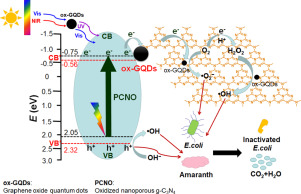当前位置:
X-MOL 学术
›
Chin. J. Catal.
›
论文详情
Our official English website, www.x-mol.net, welcomes your
feedback! (Note: you will need to create a separate account there.)
Enhanced visible-light photocatalytic degradation and disinfection performance of oxidized nanoporous g-C3N4 via decoration with graphene oxide quantum dots
Chinese Journal of Catalysis ( IF 15.7 ) Pub Date : 2020-03-01 , DOI: 10.1016/s1872-2067(19)63501-1 Jing Xu , Jin Huang , Zhouping Wang , Yongfa Zhu
Chinese Journal of Catalysis ( IF 15.7 ) Pub Date : 2020-03-01 , DOI: 10.1016/s1872-2067(19)63501-1 Jing Xu , Jin Huang , Zhouping Wang , Yongfa Zhu

|
Abstract Oxidized nanoporous g-C3N4 (PCNO) decorated with graphene oxide quantum dots (ox-GQDs) was successfully prepared by a facile self-assembly method. As co-catalysts, the ultrasmall zero-dimensional (0D) ox-GQDs can achieve uniform dispersion on the surface/inner channels of PCNO, as well as intimate contact with PCNO through hydrogen bonding, π-π, and chemical bonding interactions. In contrast with PCNO, the ox-GQDs/PCNO composite photocatalysts possessed improved light-harvesting ability, higher charge-transfer efficiency, enhanced photooxidation capacity, and increased amounts of reactive species due to the upconversion properties, strong electron capturing ability, and peroxidase-like activity of the ox-GQDs. Therefore, the visible-light photocatalytic degradation and disinfection performances of the ox-GQDs/PCNO composite were significantly enhanced. Remarkably, the composite with a 0.2 wt.% deposited amount of ox-GQDs (ox-GQDs-0.2%/PCNO) exhibited optimum amaranth photodegradation activity, with a corresponding rate about 3.1 times as high as that of PCNO. In addition, ox-GQDs-0.2%/PCNO could inactivate about 99.6% of Escherichia coli (E. coli) cells after 4 h of visible light irradiation, whereas only ˜31.9% of E. coli cells were killed by PCNO. Furthermore, h+, •O2−, and •OH were determined to be the reactive species generated in the photocatalytic process of the ox-GQDs/PCNO system; these species can thoroughly mineralize azo dyes and effectively inactivate pathogenic bacteria.
中文翻译:

通过氧化石墨烯量子点装饰增强氧化纳米多孔 g-C3N4 的可见光光催化降解和消毒性能
摘要 通过简便的自组装方法成功制备了氧化石墨烯量子点 (ox-GQDs) 修饰的氧化纳米多孔 g-C3N4 (PCNO)。作为助催化剂,超小零维 (0D) ox-GQDs 可以在 PCNO 的表面/内部通道上实现均匀分散,并通过氢键、π-π 和化学键相互作用与 PCNO 紧密接触。与 PCNO 相比,ox-GQDs/PCNO 复合光催化剂具有更高的光捕获能力、更高的电荷转移效率、增强的光氧化能力以及由于上转换特性、强电子捕获能力和过氧化物酶 -像 ox-GQDs 的活性。所以,ox-GQDs/PCNO复合材料的可见光光催化降解和消毒性能显着增强。值得注意的是,沉积量为0.2 wt.% ox-GQDs (ox-GQDs-0.2%/PCNO)的复合材料表现出最佳的苋菜光降解活性,对应的速率约为PCNO的3.1倍。此外,ox-GQDs-0.2%/PCNO 在可见光照射 4 小时后可使约 99.6% 的大肠杆菌(E.coli)细胞失活,而 PCNO 仅杀死约 31.9% 的大肠杆菌细胞。此外,h+、•O2- 和•OH 被确定为ox-GQDs/PCNO 系统光催化过程中产生的活性物种;这些物种可以彻底矿化偶氮染料并有效灭活病原菌。ox-GQDs的%沉积量(ox-GQDs-0.2%/PCNO)表现出最佳的苋菜光降解活性,对应的速率约为PCNO的3.1倍。此外,ox-GQDs-0.2%/PCNO 在可见光照射 4 小时后可使约 99.6% 的大肠杆菌(E.coli)细胞失活,而 PCNO 仅杀死约 31.9% 的大肠杆菌细胞。此外,h+、•O2- 和•OH 被确定为ox-GQDs/PCNO 系统光催化过程中产生的活性物种;这些物种可以彻底矿化偶氮染料并有效灭活病原菌。ox-GQDs的%沉积量(ox-GQDs-0.2%/PCNO)表现出最佳的苋菜光降解活性,对应的速率约为PCNO的3.1倍。此外,ox-GQDs-0.2%/PCNO 在可见光照射 4 小时后可使约 99.6% 的大肠杆菌(E.coli)细胞失活,而 PCNO 仅杀死约 31.9% 的大肠杆菌细胞。此外,h+、•O2- 和•OH 被确定为ox-GQDs/PCNO 系统光催化过程中产生的活性物种;这些物种可以彻底矿化偶氮染料并有效灭活病原菌。在可见光照射 4 小时后,大肠杆菌) 细胞,而只有约 31.9% 的大肠杆菌细胞被 PCNO 杀死。此外,h+、•O2- 和•OH 被确定为ox-GQDs/PCNO 系统光催化过程中产生的活性物种;这些物种可以彻底矿化偶氮染料并有效灭活病原菌。在可见光照射 4 小时后,大肠杆菌) 细胞,而只有约 31.9% 的大肠杆菌细胞被 PCNO 杀死。此外,h+、•O2- 和•OH 被确定为ox-GQDs/PCNO 系统光催化过程中产生的活性物种;这些物种可以彻底矿化偶氮染料并有效灭活病原菌。
更新日期:2020-03-01
中文翻译:

通过氧化石墨烯量子点装饰增强氧化纳米多孔 g-C3N4 的可见光光催化降解和消毒性能
摘要 通过简便的自组装方法成功制备了氧化石墨烯量子点 (ox-GQDs) 修饰的氧化纳米多孔 g-C3N4 (PCNO)。作为助催化剂,超小零维 (0D) ox-GQDs 可以在 PCNO 的表面/内部通道上实现均匀分散,并通过氢键、π-π 和化学键相互作用与 PCNO 紧密接触。与 PCNO 相比,ox-GQDs/PCNO 复合光催化剂具有更高的光捕获能力、更高的电荷转移效率、增强的光氧化能力以及由于上转换特性、强电子捕获能力和过氧化物酶 -像 ox-GQDs 的活性。所以,ox-GQDs/PCNO复合材料的可见光光催化降解和消毒性能显着增强。值得注意的是,沉积量为0.2 wt.% ox-GQDs (ox-GQDs-0.2%/PCNO)的复合材料表现出最佳的苋菜光降解活性,对应的速率约为PCNO的3.1倍。此外,ox-GQDs-0.2%/PCNO 在可见光照射 4 小时后可使约 99.6% 的大肠杆菌(E.coli)细胞失活,而 PCNO 仅杀死约 31.9% 的大肠杆菌细胞。此外,h+、•O2- 和•OH 被确定为ox-GQDs/PCNO 系统光催化过程中产生的活性物种;这些物种可以彻底矿化偶氮染料并有效灭活病原菌。ox-GQDs的%沉积量(ox-GQDs-0.2%/PCNO)表现出最佳的苋菜光降解活性,对应的速率约为PCNO的3.1倍。此外,ox-GQDs-0.2%/PCNO 在可见光照射 4 小时后可使约 99.6% 的大肠杆菌(E.coli)细胞失活,而 PCNO 仅杀死约 31.9% 的大肠杆菌细胞。此外,h+、•O2- 和•OH 被确定为ox-GQDs/PCNO 系统光催化过程中产生的活性物种;这些物种可以彻底矿化偶氮染料并有效灭活病原菌。ox-GQDs的%沉积量(ox-GQDs-0.2%/PCNO)表现出最佳的苋菜光降解活性,对应的速率约为PCNO的3.1倍。此外,ox-GQDs-0.2%/PCNO 在可见光照射 4 小时后可使约 99.6% 的大肠杆菌(E.coli)细胞失活,而 PCNO 仅杀死约 31.9% 的大肠杆菌细胞。此外,h+、•O2- 和•OH 被确定为ox-GQDs/PCNO 系统光催化过程中产生的活性物种;这些物种可以彻底矿化偶氮染料并有效灭活病原菌。在可见光照射 4 小时后,大肠杆菌) 细胞,而只有约 31.9% 的大肠杆菌细胞被 PCNO 杀死。此外,h+、•O2- 和•OH 被确定为ox-GQDs/PCNO 系统光催化过程中产生的活性物种;这些物种可以彻底矿化偶氮染料并有效灭活病原菌。在可见光照射 4 小时后,大肠杆菌) 细胞,而只有约 31.9% 的大肠杆菌细胞被 PCNO 杀死。此外,h+、•O2- 和•OH 被确定为ox-GQDs/PCNO 系统光催化过程中产生的活性物种;这些物种可以彻底矿化偶氮染料并有效灭活病原菌。











































 京公网安备 11010802027423号
京公网安备 11010802027423号